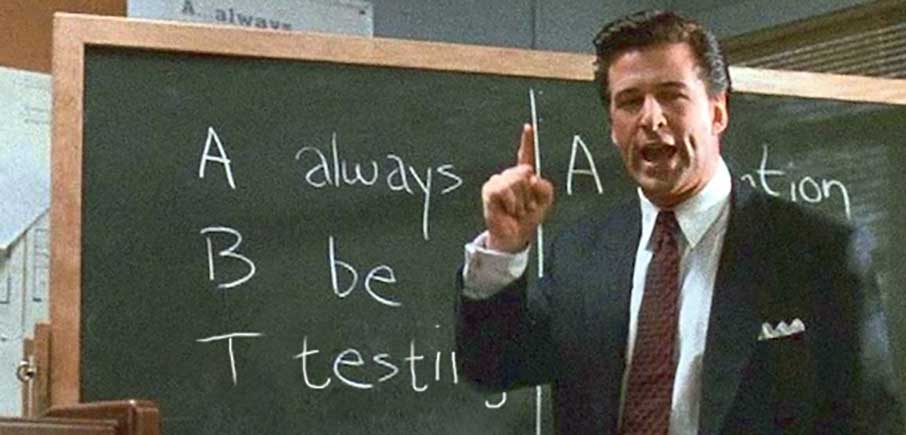There are few questions for which the answer is always “yes.”
Do you want coffee? Yes. Always yes. There is never a bad time for the nectar of the gods.
Should you re-watch another episode of Game of Thrones? Yes. Every episode is amazing. Every single one deserves a second look.
Should you be testing your digital products? Yes. Absolutely. Always. Here’s why…
When clients talk with us about testing, they most often think of it as the thing we do after production before launch. But it’s critical we shift that thinking early on in the project because usability testing is not a point in time or task in the queue… it’s a state of mind.
The best way to think about usability testing is as an ongoing, iterative process that makes the product perform better for the users, and helps the users have the best experience possible with the product. To many clients’ surprise, it can (and should) start well before we begin our work together, and can be continued after the product has been rolled out.
To help shine a light on the Whistle Studios perspective on usability testing, I’m going to break it down into components. There will be a test at the end. (Get it? A test? Because it’s about testing… Moving on.)
Who should be doing the testing?
Usability testing can (and should) be conducted by the client and by the agency partner doing the research and development. It is an ongoing, collaborative process.
Clients should feel empowered to tackle some basic usability testing. This unfamiliar process can feel daunting, but your partner should be thrilled to show you the ropes. The more you know — and share with them — what you know about your users and how they use the app before getting started, the better. Have ongoing conversations about how the app is being used as time passes so they can help you make updates and improvements on a continual basis.
Your partner will also do comprehensive usability testing during the prototyping, development, and quality assurance phases of the build. Whistle, as a partner, is obsessed with the user’s experience, after all, why would you build an app if you didn’t want the users to love, you know, using it?
What do we need in order to test effectively?
An unbiased perspective, an open mind, willing participants, good questions, and a few tools of the trade.
Staying objective when observing or testing a user’s experience can be a test in humility. The most important thing to recognize is this is the perfect time to be wrong. If you ask users to complete a task and they can’t, well that’s great news! (OK, not great but it does mean you’re on your way to greatness!) By accepting the feedback with an open mind, you can immediately begin the process of course correction and figure out a way to help users have a positive experience which means a fast-track to better outcomes for your organization.
Finding users to test is often the hardest part. Here are a few ways to get them on board to help:
- Your followers: Ask folks who love your brand or use your product to volunteer — and reward them!
- Colleagues: Ask around the office for people who didn’t work on the build project and can be objective
- Interns: Believe it or not, can be a fresh set of eyes and provide a fresh perspective
- Coffee shops: Post up in a Coffee shop with a sign requesting volunteers and a stack of gift cards for the shop. This is a way to get a diverse and unbiased perspective — just check with the manager first.
- UserTesting.com: Need I say more? UserTesting.com is a stalwart in the user testing world, and a great place to get started.
As far as what you need in the way of tools for testing, asking participants to complete specific tasks and following up with good questions is really the most important. Make sure every question is helping move toward an answer about the user’s experience and gets you closer to making it better.
Besides the right questions, here are a few other resources for your tool-belt to do usability testing on your own:
- Join.me or UberConference: No one likes to have someone looking over their shoulder, especially when they are doing unfamiliar tasks on unfamiliar websites or apps. Keep a conversational tone to make them comfortable, and keep your distance so you can effectively observe. A screen sharing app is probably the most important software tool in user testing
- Silverback: This app lets you record the tester’s screen, and make annotations in the recording in real time! After hours of testing (yes, hours), it’s hard to go back and remember everything you noticed during each test. By making notes in the recording in real time, you can get accurate accounts of the experience and more robust reports to use for optimization.
- Reflector: Developing a mobile app? This wireless screen sharing app for mobile devices is for you. Let users experience your app as they would use it in real life — without a wire tethering them to your computer, and without you looking over their shoulder.
- Evernote or Google Docs: However you plan to take notes, make sure they are being taken, saved, organized, and reported back to the team. Here’s the main tip for this one: Appoint someone who isn’t the primary observer to take notes. Delegate this task so you can stay focused, present, and ready to hold the tester’s hands. You are there to remind them that if they fail at a task, it’s not their fault. It’s YOUR fault. And the more ways they can show you where the trip ups and failures are happening, the better the end product will be.
When should we be testing?
Always. Be. Testing. As I mentioned above, there are a few key points in time for you to test with users: before, during, and after launching the project, and when you get a sneaking suspicion that something is off.
Before you engage a partner like Whistle Studios, do some usability testing on your current app or website to see what is working, what’s not, what people like and don’t like, and how they feel about using competitor products. Having this type of insight before the project starts is great.
After the product is delivered and out there in the wild, check in on how real users are using it. Validate the assumptions we made during development. Watch smiles crawl across the faces of happy customers.
The last reason I’ll mention here to test is when you know something is off. It could be that your analytics are showing a drop in performance, your help desk is getting inundated with questions, or you just have a hunch or an itch that you want to gut-check. If you think there could be a problem, take a peek. There’s no harm in testing, and potentially a lot of good.
Where are tests most effective in making a significant impact on user experience?
There are a few areas that get a lot of love when it comes to usability testing — mostly conversion experiences like registration forms, checkout carts, and sign up processes. But there are hidden areas of great opportunity that you should keep your eyes on, like the new user experience, notifications, share tools, and core capabilities. If it matters to your user or your bottom line, test it.
Why should we perform usability tests?
Because your user deserves it and your bottom line requires it.
Look, the fact is you don’t build a new product for the glory. You build products to further your business objectives; you build them for people to use. If users can’t use your product or dread using it, that’s a problem. Ongoing, solid usability testing can prevent that situation or head it off at the pass.
One last thing worth noting…
It’s critically important to share what you learn during these tests with your team. Everyone’s goal should be to deliver a good product that will delight users, but ego, fear, and embarrassment can get in the way. Once you have your findings, order a pizza and sit down with the team. Have a frank discussion about what you learned, and decide on steps to take to incorporate those learnings. Openness, honesty, and a willingness to change is the only way to create a product people love.
Originally published on the Whistle Studios Blog here.






0 Comments